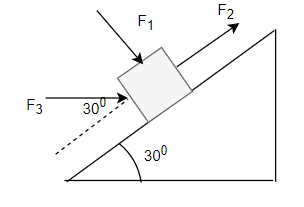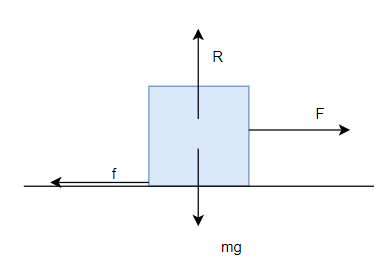Many times in a problem we have multiple forces acting on the body and we need to calculate work done by Multiple force. This can be done in these simple steps
(1) First draw a free body diagram of the body showing all the forces on it.
(2) Carefully choose a X-Y coordinate system so that direction of the motion or direction of force lies in X or Y direction. This will simplify the Problem
(3) Applying Newton’s law find out any unknown forces
(4) Find the work done by individual forces using the formula
$W= \mathbf{F}.\mathbf{d}$
The work done is the scalar product of the Force and displacement vector
This can be written as
$W=Fd \cos \theta $
And net Workdone will be the Sum of the workdone of the individual forces
$W=W_{1}+W_{2}+W_{3}$
Another way would be to first find the net Force on the object ( Vector Sum)
$\mathbf{F}_{net}=\mathbf{F}_{1}+\mathbf{F}_{2}+\mathbf{F}_{3}$
And then
$W= \mathbf{F}_{net} .\mathbf{d}$
$W_{net}=F_{net}d \cos \theta$
(5) The Work done can also be calculated using the Scalar dot product if the forces and displacement vectors are given
W= F.d
(6) All the above steps are applicable if the force acting is constant,if the force is of varying nature,then it becomes little bit complicated to find out
(a) The force in a spring depends on the distance from the equilibrium position,so it is of varying nature.In such a case,following could be used to calculate the work done
$W=\int_{a}^{b}f_{x}xdx$
where $f_{x}x$ is the force varies with x.
This could also be calculated using the graphical method. It is the area of the curve plotted between force component parallel to displacement between the two points
Example -1
A block moves up an inclined plane of 30° under the action of the three forces shown in the below figure
$F_3= 40 N$ and horizontal direction
$F_1=10 N$ and Normal to the plane
$F_2=30 N$ and parallel to the plane
Determine the work done by each of these forces and net work done as the block moves up 100 cm the incline

Solution
Work done by the Force $F_3$ is given by
$W_3 = F_3 d \cos \theta$
$=10 \times 1 \times .866= 8.66$ J
Work done by the Force $F_1$ is given by
$W_1 = F_1 d \cos \theta$
$=10 \times 1 \times 0= 0$ J
Since force act perpendicular to the direction of movement. Work done is zero
Work done by the Force $F_2$ is given by
$W_2= F_2 d \cos \theta$
$=30 \times 1 \times 1= 30 $ J
Hence Net work done= $W_1 + W_2 + W_3 = 0 + 30 + 8.66= 38.66 $J
Example 2
A 10 kg box is pulled on the rough horizontal floor at a constant speed of 20 cm/s by a horizontal force. The coefficient of friction between the block and floor is .20.
(a) Find the work done by pulling force per second
(b) Find the work done by the friction force per second
(c) Net work done on the box

Solution:
Since the speed is constant
$\mathbf{F}= \mathbf{f}$
Now
$f= \mu mg= .30 \times 10 \times 9.8 = 29.4 $N
Therefore $F= 29.4 $N
Now displacement in 1 sec(d) = 20 cm = .2 m
(a) Work done by the Pulling Force
$W_1 = Fd= 29.4 \times .2= 5.88$J
(b) Work done by the Friction Force
$W_2 = -fd= -29.4 \times .2= -5.88$J ( Negative sign as friction is opposite to direction of movement)
(c) Net work done
$W= W_1 + W_2 = 0$
Solved Questions
Question 1
An object being pushed on a horizontal surface with two forces: one of 10 N acting in the direction of motion and another of 5 N acting at an angle of 60 degrees to the direction of motion. If the object moves 2 meters, what will be the net work done
Solution
Work done by the 10 N force: $W_1 = F_1 \cdot d = 10 \cdot 2 = 20$ Joules, since the force is parallel to the direction of motion ($\cos(0^\circ) = 1$).
Work done by the 5 N force: $W_2 = F_2 \cdot d \cdot \cos(\theta_2) = 5 \cdot 2 \cdot \cos(60^\circ) = 5 \cdot 2 \cdot 0.5 = 5$ Joules, as the force has a component along the direction of motion.
Total work done: $W_{\text{total}} = W_1 + W_2 = 20 + 5 = 25$ Joules.
Question 2
A box is pulled across a rough surface for a distance of 4 meters. It is subjected to a pull of 20 N at an angle of 45 degrees to the horizontal, while the coefficient of kinetic friction between the box and the surface is 0.1. The mass of the box is 10 kg. Calculate the total work done on the box, considering gravity, normal force, applied force, and friction. (Assume g = 9.8 m/s²)
Solution
Given:
- Pull force ($F$) = 20 N, at an angle of 45 degrees.
- Distance ($d$) = 4 meters.
- Coefficient of kinetic friction ($\mu_k$) = 0.1.
- Mass of the box ($m$) = 10 kg.
- Gravity ($g$) = 10 m/s².
Normal Force ($N$):
The normal force is altered by the vertical component of the applied force.
$$
N = mg – F \sin(45^\circ) = 10 \cdot 10 – 20 \cdot \frac{\sqrt{2}}{2} = 100 – 10\sqrt{2} \, \text{N}
$$
Frictional Force ($F_{\text{fric}}$):
$$
F_{\text{fric}} = \mu_k N
$$
Substitute the value of $N$ from step 1 to find $F_{\text{fric}}$.
Work done by the Applied Force ($W_{\text{app}}$):
$$
W_{\text{app}} = F \cos(45^\circ) \cdot d = 10 \sqrt 2 \cdot 4
$$
Work done against Friction ($W_{\text{fric}}$):
$$
W_{\text{fric}} = -F_{\text{fric}} \cdot d = -.1 (100 – 10\sqrt{2}) \times 4=-(10 – \sqrt 2) \times 4
$$
The work is negative because friction opposes the motion.
Total Work:
$$
W_{\text{total}} = W_{\text{app}} + W_{\text{fric}}= 40 \sqrt 2 -40 + 4 \sqrt 2 = 44 \sqrt 2 -40
$$
Question 3
A 2 kg object is lifted 3 meters vertically by a force 100 N acting at an upward angle of 60 degrees. An additional horizontal force of 15 N acts on the object during the lift. Calculate the total work done on the object, considering the weight of the object and the applied forces.
Solution
Given:
- Mass ($m$) = 2 kg.
- Vertical distance ($d$) = 3 meters.
- Lifting force = 100 N
- Lifting force angle = 60 degrees.
- Horizontal force ($F_h$) = 15 N.
Work Done Lifting the Object:
The vertical component of the lifting force does work against gravity.
- Calculate the vertical component of the lifting force.
- Calculate work done by this force: $W_{\text{lift}} = F_{\text{vert}} \cdot d = 100 \times 3 \times cos 60 = 150 J$.
Work Done by Gravity:
Work done by gravity is $W_{\text{grav}} = -mgd =-3 \times 10 \times 3 = -90 J $, negative because it opposes the lifting direction.
Work Done by the Horizontal Force:
Since there’s no displacement in the horizontal direction during the lift, $W_{\text{horiz}} = 0$.
Total Work:
$$
W_{\text{total}} = W_{\text{lift}} + W_{\text{grav}} + W_{\text{horiz}} = 150 -90= 60 J
$$
Question 4
A box is moved along the floor from point $A$ to point $B$, with the displacement vector given by $\vec{d} = 4\hat{i} + 3\hat{j}$ meters. Two forces act on the box during the displacement: a force $\vec{F_1} = 5\hat{i} – 2\hat{j}$ Newtons and a force $\vec{F_2} = -3\hat{i} + 4\hat{j}$ Newtons. Calculate the total work done on the box by these forces.
Solution
The work done by a force during a displacement is given by the dot product of the force vector and the displacement vector: $W = \vec{F} \cdot \vec{d}$.
Work Done by $\vec{F_1}$
$$
W_1 = \vec{F_1} \cdot \vec{d} = (5\hat{i} – 2\hat{j}) \cdot (4\hat{i} + 3\hat{j})
$$
$$
W_1 = (5 \times 4) + (-2 \times 3) = 20 – 6 = 14 \, \text{Joules}
$$
Work Done by $\vec{F_2}$
$$
W_2 = \vec{F_2} \cdot \vec{d} = (-3\hat{i} + 4\hat{j}) \cdot (4\hat{i} + 3\hat{j})
$$
$$
W_2 = (-3 \times 4) + (4 \times 3) = -12 + 12 = 0 \, \text{Joules}
$$
The total work done on the box is the sum of the work done by each force:
$$
W_{\text{total}} = W_1 + W_2 = 14 \, \text{Joules} + 0 \, \text{Joules} = 14 \, \text{Joules}
$$
Question 5
A force acts on an object along the x-axis according to the force law $F(x) = 2x^2 \, \text{N}$, where $x$ is in meters. Calculate the work done by this force as the object moves from $x = 1 \, \text{m}$ to $x = 3 \, \text{m}$.
Solution
For a variable force, work done ($W$) can be calculated by integrating the force function over the path of movement. The work done is given by the integral:
$$ W = \int_{x_1}^{x_2} F(x) \, dx $$
Substituting the given force function:
$$ W = \int_{1}^{3} 2x^2 \, dx $$
Let’s compute the integral:
$$ W = \left[ \frac{2x^3}{3} \right]_{1}^{3} $$
$$ W = \frac{2(3^3)}{3} – \frac{2(1^3)}{3} $$
$$ W = \frac{2 \cdot 27}{3} – \frac{2 \cdot 1}{3} $$
$$ W = 18 – \frac{2}{3} = 17\frac{1}{3} \, \text{J} $$
I hope you like this post on How to find work done by Multiple forces acting on a object
Also Reads
calculate force from potential energy
physics formulas
work done Formula
how to solve kinematics problems
 Skip to content
Skip to content
Ok thanks nice super sir